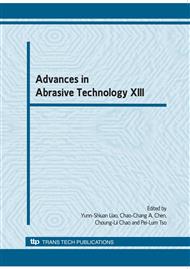p.591
p.597
p.603
p.609
p.615
p.621
p.627
p.633
p.639
Intermittent Grinding of Advanced Ceramic with the T-Tool Grinding Wheel
Abstract:
The application of advanced ceramics in high-tech industries is increasing considerably due to their superior properties. However the difficulties involved and manufacturing costs have been impediments to the widespread replacement of metals by the advanced ceramics. One of the main targets in grinding of these materials is increasing the machining efficiency while preserving the surface integrity. Hence in order to reduce the grinding forces and temperatures and increase the material removal rate, a specially designed segmented wheel (T-Tool) has been developed. Reducing the static cutting edges via segmenting the wheel which automatically leads to reduction of momentarily engaging cutting edges results in a reduction of rubbing and plowing regimes and therefore a decrease in the specific grinding energy. The obtained results show that the application of the T-Tool wheel can increase the G-ratio and decrease the grinding forces considerably. A decrease of up to 35% of grinding forces has been achieved.
Info:
Periodical:
Pages:
615-620
Citation:
Online since:
August 2010
Authors:
Price:
Сopyright:
© 2010 Trans Tech Publications Ltd. All Rights Reserved
Share:
Citation:


